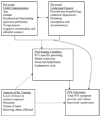Parenting and temperament prior to September 11, 2001, and parenting specific to 9/11 as predictors of children's posttraumatic stress symptoms following 9/11
- PMID: 20589557
- PMCID: PMC2897067
- DOI: 10.1080/15374416.2010.486317
Parenting and temperament prior to September 11, 2001, and parenting specific to 9/11 as predictors of children's posttraumatic stress symptoms following 9/11
Abstract
Parenting is related to children's adjustment, but little research has examined the role of parenting in children's responses to disasters. This study describes parenting responses specific to the 9/11 terrorist attacks and examines pre-9/11 parenting, child temperament, and 9/11-specific parenting as predictors of children's posttraumatic stress (PTS) symptoms among children geographically distant from the attack locations. A community sample of children and parents (n = 137, ages 9-13 years) participating in an ongoing study were interviewed 1 month following 9/11. Parents reported engaging in a number of parenting responses following 9/11. Pre-9/11 acceptance and 9/11-specific, self-focused parental responses predicted PTS symptoms. Pre-9/11 parenting and temperament interacted to predict PTS symptoms, suggesting that parenting and temperament are important prospective predictors of children's responses to indirect exposure to disasters.
Figures
Similar articles
-
Pre-attack symptomatology and temperament as predictors of children's responses to the September 11 terrorist attacks.J Child Psychol Psychiatry. 2005 Jun;46(6):631-45. doi: 10.1111/j.1469-7610.2004.00378.x. J Child Psychol Psychiatry. 2005. PMID: 15877768
-
Parent-Reported Child Reactions to the September 11, 2001 World Trade Center Attacks (New York USA) in Relation to Parent Post-Disaster Psychopathology Three Years After the Event.Prehosp Disaster Med. 2018 Oct;33(5):558-564. doi: 10.1017/S1049023X18000869. Epub 2018 Oct 8. Prehosp Disaster Med. 2018. PMID: 30295206
-
Pre-attack stress-load, appraisals, and coping in children's responses to the 9/11 terrorist attacks.J Child Psychol Psychiatry. 2006 Dec;47(12):1219-27. doi: 10.1111/j.1469-7610.2006.01664.x. J Child Psychol Psychiatry. 2006. PMID: 17176377 Free PMC article.
-
Nature and nurturing: parenting in the context of child temperament.Clin Child Fam Psychol Rev. 2011 Sep;14(3):251-301. doi: 10.1007/s10567-011-0093-4. Clin Child Fam Psychol Rev. 2011. PMID: 21461681 Free PMC article. Review.
-
Parenting practices as potential mechanisms for child adjustment following mass trauma.J Marital Fam Ther. 2008 Apr;34(2):177-92. doi: 10.1111/j.1752-0606.2008.00063.x. J Marital Fam Ther. 2008. PMID: 18412825 Review.
Cited by
-
Emotion Regulation in Families: Exploring the Link between Parent-Child Alexithymia and Child Post-Traumatic Stress Symptoms Amidst the COVID-19 Pandemic.Child Psychiatry Hum Dev. 2024 Jun 14. doi: 10.1007/s10578-024-01728-9. Online ahead of print. Child Psychiatry Hum Dev. 2024. PMID: 38874751
-
Testing the Effects of COVID-19 Confinement in Spanish Children: The Role of Parents' Distress, Emotional Problems and Specific Parenting.Int J Environ Res Public Health. 2020 Sep 24;17(19):6975. doi: 10.3390/ijerph17196975. Int J Environ Res Public Health. 2020. PMID: 32987641 Free PMC article.
-
Making sense of the pandemic: Parent-child conversations in two cultural contexts.PLoS One. 2023 Jan 23;18(1):e0280781. doi: 10.1371/journal.pone.0280781. eCollection 2023. PLoS One. 2023. PMID: 36689431 Free PMC article.
-
Research Methods in Child Disaster Studies: A Review of Studies Generated by the September 11, 2001, Terrorist Attacks; the 2004 Indian Ocean Tsunami; and Hurricane Katrina.Child Youth Care Forum. 2013 Aug 1;42(4):285-337. doi: 10.1007/s10566-013-9211-4. Child Youth Care Forum. 2013. PMID: 24443635 Free PMC article.
-
Family influences on the long term post-disaster recovery of Puerto Rican youth.J Abnorm Child Psychol. 2013 Jan;41(1):111-24. doi: 10.1007/s10802-012-9654-3. J Abnorm Child Psychol. 2013. PMID: 22688681 Free PMC article.
References
-
- Achenbach TM. Manual for the Child Behavior Checklist/4–18 and 1991 Profile. Burlington, VT: University of Vermont Department of Psychiatry; 1991.
-
- Aiken LS, West SG. Multiple Regression: Testing and Interpreting Interactions. Thousand Oaks, CA: Sage Publications; 1991.
-
- Belsky J. Differential susceptibility to rearing influence: An evolutionary hypothesis and some evidence. In: Ellis B, Bjorklund D, editors. Origins of the social mind: Evolutionary psychology and child development. New York: Guilford; 2005. pp. 139–163.
-
- Biesanz JC, West SG. Towards understanding assessments of the Big Five: Multitrait-Multimethod analyses of convergent and discriminant validity across measurement occasion and type of observer. Journal of Personality. 2004;72:845–876. - PubMed
-
- Capaldi DM, Rothbart MK. Development and validation of an early adolescent temperament measure. The Journal of Early Adolescence. 1992;12:153–173.
Publication types
MeSH terms
Grants and funding
LinkOut - more resources
Full Text Sources
Medical



